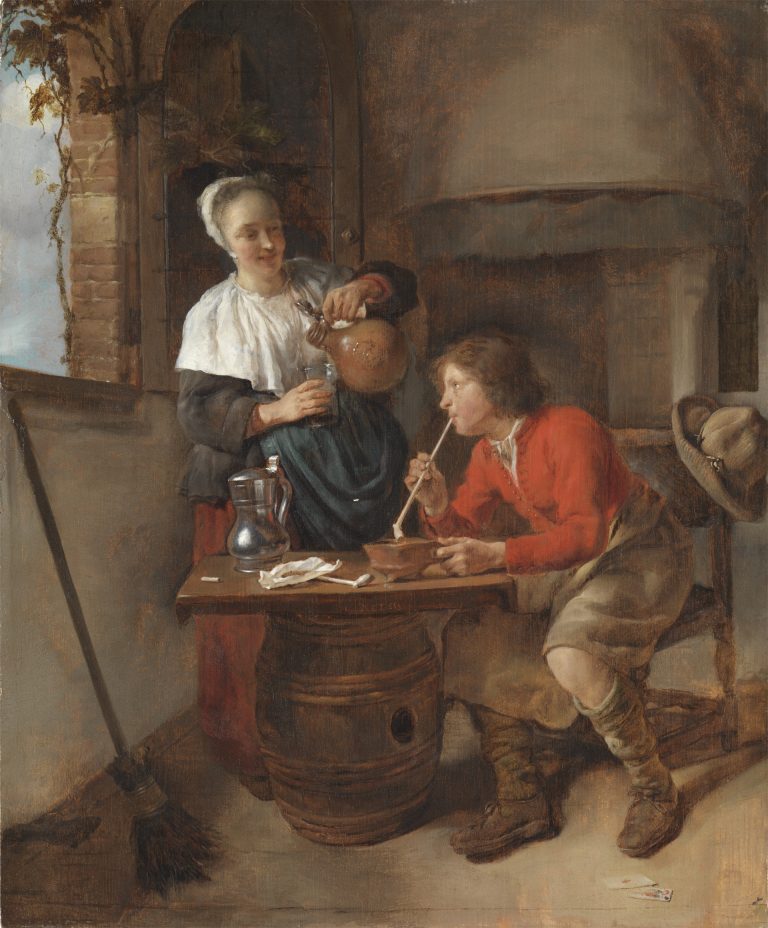In this convivial tavern scene, a young man dressed in a bright red shirt, brown shorts and stockings leans forward in his seat to light his pipe from the hot coals in the brazier he holds in his left hand. An attractive waitress, who stands behind the makeshift table in front of the youth, smiles endearingly at him as she pours him a glass of beer from an earthenware jug. The hat resting on the back of the man’s chair indicates that he has just arrived in the tavern and has settled in to enjoy his drink and tobacco.
Dutch artists frequently depicted figures smoking in their genre paintings, but the place of tobacco in that society was a subject of great debate. On the one hand, medical experts had drawn attention to the benefits of the plant, which had first been imported to the Netherlands in the late sixteenth century. In his widely read Schat der gesontheydt (Treasury of Health) of 1636, Johann van Beverwijck argued that tobacco was a prophylactic against one of the deadliest diseases of his time, the plague.1 On the other hand, the recreational use of tobacco was criticized because the effects of smoking were considered to be similar to those of consuming alcohol.2 Moreover, smoking carried a social stigma, as initially it enjoyed popularity among sailors, soldiers and the lower rural classes, precisely those groups from which the middle class preferred to distance itself. Over the course of the century, however, the tobacco industry expanded, and smoking became a widely accepted leisure pastime, even among the upper classes.
In this painting, Gabriel Metsu seems little concerned with making a moral judgment about the young man’s enjoyment of smoking, and more interested in depicting the gentle rapport between him and the appealing woman serving him his beer. The length of the man’s pipe even hints at his somewhat respectable status. Poor people could afford only unpolished short-stemmed pipes, whereas members of the middle classes used pipes with longer stems that cooled off the smoke and softened the somewhat bitter taste of burnt tobacco.3
Metsu painted this work in 1656–58, during his early Amsterdam years when he often depicted men and women enjoying tobacco or alcohol in public houses. His first painting of a couple drinking together is A Man and a Woman Sharing a Meal from the Rijksmuseum, Amsterdam (fig 1), which draws on an inn scene from about 1650 by Gerard ter Borch (1617–81).4 Metsu subsequently made two variations of the subject: the present work and A Man Smoking a Pipe at a Fireplace (fig 2). Aside from the different times of the day depicted in these works, they also differ in the character of the relationships of the two protagonists. In the Leiden Collection painting the scene depicts a waitress and a young customer, and nothing more.5 In A Man Smoking a Pipe at a Fireplace, however, the smiling interactions and postures of the young man and woman suggests that an amorous tension exists between them.
In the eighteenth century, when each of these paintings was first recorded, the value of Young Man Smoking and a Woman Pouring Beer was substantially higher than that of the night scene. The Dutch painter and art dealer Philips van Dijk (1683–1753) sold the two paintings to Johan Hendrik Graaf van Wassenaar Obdam from The Hague in 1730 and 1734, at which time he received more than double the price for Young Man Smoking and a Woman Pouring Beer (315 florins) as he did for the night scene (150 florins).6 Van Wassenaar’s heirs sold the latter picture after the collector’s death in 1653, but they held on to Young Man Smoking and a Woman Pouring Beer for some 20 years, eventually selling it in 1769. The difference between the sales prices is again telling: A Man Smoking a Pipe at a Fireplace sold for 283 florins, while the present painting fetched again more than twice as much: 605 florins. This work then passed through several prominent eighteenth- and nineteenth-century collections, including those of the Duc de Choiseul-Praslin, the Baron de Beurnonville, and Edward Cecil Guinness.
